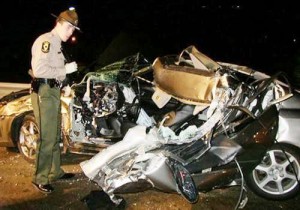As the United States celebrates Independence Day, an average of 148 people die in motor vehicle crashes each year – far above the daily average.
An analysis of Federal fatal crash data shows that July 4, August 13, July 15, and January 1 were the days with most crash deaths during 2004-2008. That compares with 114 deaths that occurred on the average day, according to the Insurance Institute for Highway Safety.
“Why do we tolerate so many highway deaths?” asks Adrian Lund, president of the independent Institute.
In Lund’s view, it is not that U.S. society has become unconcerned about motor vehicle crashes. Rather the U.S. emphasizes the wrong aspects of the threat, while ignoring many proven ways to reduce deaths and injuries on the highway.
For example, Lund notes that Congress held extensive public hearings on the Toyota safety defects, even though the risk to millions of Toyota drivers is statistically small. On the other hand, speeding is a factor in one-third of all highway deaths.
Compared with the Toyota controversy, there is no clamor for Congressional action calling for tough enforcement against speeding. There is no victims’ advocacy group urging installation of speed controls on all vehicles that could prevent drivers from exceeding the legal limit. (Try getting these past angry voters – Z)
Lund points out that instead, Congress repealed the national maximum speed limit in 1995. Since then state after state has raised speed limits on many roads, costing thousands of lives. A petition to require controls to cap the top speed of large commercial trucks has languished for three years.
Meanwhile, distracted driving and cell phone use behind the wheel are getting all the attention. With much fanfare, states are enacting bans targeting various aspects of phone use by drivers, especially texting.
Yet, according to Lund, there is little evidence that the laws will work.
“While we may find an effective legislative solution in the future, the results so far are not encouraging. Recent research by my organization on hand-held cell phone bans enacted in three states and the District of Columbia found that the laws are not reducing crashes even though hand-held phone use declined,” Lund said.
“Why is our aim so far off? For one thing, officials are reluctant to take on the vocal opponents they would have to cross to implement some of the tough enforcement programs that research shows are effective. In contrast, it’s been fairly easy to enact bans on texting while driving because they affect younger people, who usually do not march on state houses or vote in large numbers,” notes Lund.
The bottom line: “We should not forget that we have made significant progress over the years on some big highway safety problems. Through regulations and government and insurance industry crash-testing programs, vehicles are safer than ever before.
“Through “Click It or Ticket” enforcement campaigns, the percentage of American drivers buckled up has risen to 84%. But progress in many other important areas has stalled or reversed course because too often we let ourselves become distracted from what really works,” Lund concludes.

